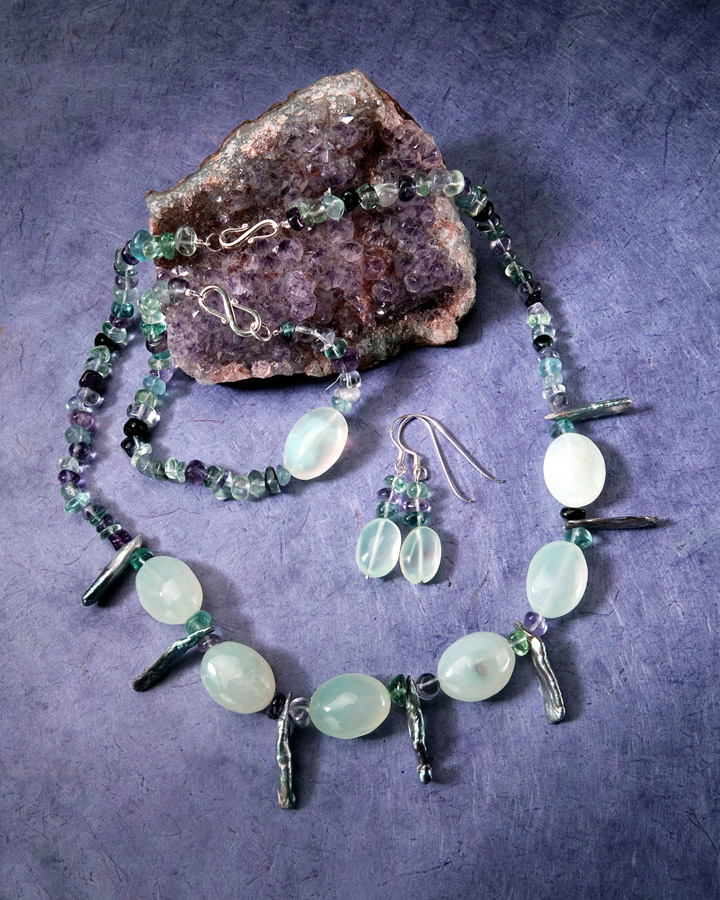When I design jewelry, two of my greatest delights are (1) to combine something from the Earth with something from the Sea and (2) to gather the component elements from a variety of countries or continents, symbolically gathering the world together. The earth and the sea call out to me: to be respected, to be restored, for their beauty to be revealed. It is not often that I get to do both as in the design. ‘Peach Jade & Natural Pearls’
I have noticed I am most creative when my choices are limited by what is available, in cooking and in other arts. If too much of some component is available, I can get lazy and my work stale. Improvisation with what I do have is delightful to me; rising to a challenge keeps me refreshed. I also believe that trait is what helps me to be patient when a piece has to wait, sometimes for years, till I can find what is needed to bring it to full fruition. And what a payback! That profound satisfaction and joy makes the wait worthwhile: please see Autumn Torsade.
The large Jade pillow beads in this set come from Asia and are Nephrite. The pearls are naturally grown and naturally colored, by minerals in the water where they grew. The smaller pillow beads are Peruvian Opal. The large round bead is made from a quartz crystal called Lodolite mined in Brazil.
The soft pastel of the Jade seemed to require pairing with the undyed natural pearls in two sizes. I could not find Peach Jade in a smaller pillow bead to finish the design, so as happens from time to time, I decided to wait till I could find an acceptable substitute to finish the jewelry. This was difficult to do, because it is impossible to match colors from even the best of digital images. Finding a strand of Peruvian Opal beads at my only local dealer some time later was unbelievably fortuitous and only a few stones on that strand matched well enough to use. What a blessing! So worth the wait.
Silvercloud
As you probably know by now, if you’ve read very many of my pages, I much prefer a stone that “paints a picture”. So, that means I enjoy making jewelry with interesting colors and patterns. Sometimes I sit looking at a bead, especially Rhyolite (please use link to the Rhyolite pieces), almost entering into the swirling shapes, entranced with its natural abstractions, praising the Creator. ???????
For artists who want their work to express harmony, their task is always to create a balance between variety and uniformity. Too much variety creates confusion; too little, boring. Design Catagory
I much prefer to use natural pearls whenever I can. I don’t even think cultured pearls, now flooding the market, are a good substitute, especially those that are dyed every color imaginable. I can’t say why. Perhaps it’s my reverence for what hasn’t been “messed with” (HOWEVER, please see link to Baroque Peacock Pearls re: CONFESSIONS). I understand that it is now, unfortunately, almost impossible to find any stones that haven’t been enhanced, heated or irradiated. But if I CAN find them, I am glad and even a bit honored to make them into something lovely. When I CAN’T, I disclose it, even if their “de-natured” state was not revealed to me when I purchased them. Sometimes I can’t tell though. Personal Philosophy
When I get strands of stones with variations of shape, size, pattern or color, I begin by sorting them. Then I count the number in each category. That gives me a start at knowing how to design. Will it be enough for a necklace; must I add other elements, what size and color? For example, see the several pieces made with Botswana Agate. When I sorted them, I found a limited number of horizontally striped beads and more of vertically and diagonally striped. Then quite a number of stones showed a crystalline nature. Thus I was able to add the mostly white Howlite to the fewest ones, with horizontal striping; make a double strand with the other striped stones; and by adding rock crystals and a large Onyx pendant to the third category of stones, create a completely different look: the same stone with differing interpretations. This procedure is also evidenced in the 6 Olive Jade designs and in the 15 Fireworks Jaspar pieces. Design Process
